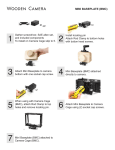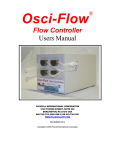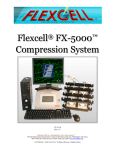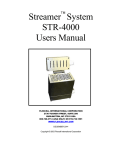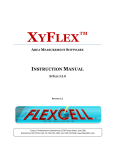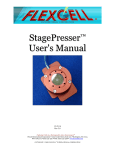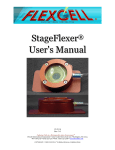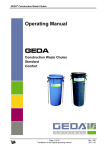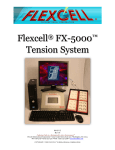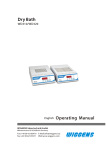Download Sample Preparation and Setup of BioPress ™ Culture Plates and
Transcript
Tech Report 111: Sample Preparation and Setup of BioPress™ Culture Plates and Compression Baseplate Assembly Author: Chris Wimmer Document: BioPress and Compression Baseplate Assembly Tech Report, Rev 1.1 01-07-2015 ™ DunnCulturing Labortechnik · Thelenberg 6 · 53567 Asbach Cells in aGmbH Mechanically Active Environment International Corporation Tucker Suite 200 Burlington, NC 27215 Tel. +49 (0) 26 83 Flexcell / 4 30 94 · Fax +49 (0) 26 83 2730 / 4 27 76 · Street, e-mail: [email protected] · Internet: www.dunnlab.de 800-728-3714 (919) 732-1591 FAX: (919) 732-5196 www.flexcellint.com COPYRIGHT © 2009 FLEXCELL INTERNATIONAL CORPORATION FLEXCELL® INTERNATIONAL CORPORATION The BioPress™ compression culture plate contains a foam ring and sample holder in each well (Fig. 1). The foam ring is used to contain the removable sample holder. In preparing samples, be sure that the sample thickness is no less than 1000 m and no greater than 0.118” (3 mm). The thickness of the compressed foam is 350 m; therefore, thinner samples will not be compressed. A sample thickness of 1000 m or more will ensure compressibility. The maximum chamber height is 0.122” (3.1 mm); therefore samples with a thickness greater than 0.118” (3 mm) will be preloaded when the platens are inserted into the wells of the culture plates. contained within the foam ring. Do this for the remainder of the wells. Add 3-5 mL of culture medium to each well. Prepare all stationary platens by adjusting the center screw (Fig. 2) such that the screw bottom (part that touches the sample) is exactly flush with the bottom of the platen body. Use a pair of sterile forceps and the two holes at the adjustable center of the platen to turn the center screw. Figure 2. Stationary platen and compression culture plate Figure 1. Compression culture plate foam ring and sample holder Place a stationary platen into each well of the compression plate (Fig. 2). Calculate the number of revolutions required to bring the bottom of the center screw to the point where it just touches the top of the sample by using the following equations: The sample diameter should be equal to or less than the inner diameter of the foam sample holder in the chamber, which is 0.200” (5 mm). If the user wishes to use a larger sample, they can remove the sample holder and place the sample within the larger ring that normally contains the sample holder. This will allow a sample diameter of up to 0.525” (13 mm). For sample height in millimeters, x = (3.11-h) / 0.62 To prepare a sample for loading, remove the sample holder from the plate using a pair of sterile forceps. Place the tissue or gel sample into the hole at the center of the removable sample holder. Carefully place the sample holder back into the BioPress™ compression plate so that it is where x is the # of 180 degree clockwise turns required for the center screw to touch the sample and h is the sample height in millimeters. 1 FLEXCELL® INTERNATIONAL CORPORATION For sample height in inches: x = (0.122-h) / 0.025 where x is the # of 180 degree clockwise turns required for the center screw to touch the sample and h is sample height in inches. NOTE: If the sample height is larger than 3.11 mm (0.122”), ‘x’ in the above equations will be a negative number. In this case, the bottom of the center screw will compress the sample when it is flush with the bottom of the platen body as the platen is first inserted into the well. To compensate for this, the center screw can be turned counterclockwise ‘x’ number of turns; however, it should be noted that the sample will no longer be fully compressible, as the base of the sample holder will no longer be able to contact the base of the center screw. Baseplate without plates Baseplate with plates Using sterile forceps, turn the center screw clockwise the number of turns required by the above equation(s). Be careful not to screw the center down too far as this will preload the sample and give inaccurate force readings. Add or remove fluid medium through any of the eight holes around the inner periphery of the platen (Fig. 2). Figure 3. Baseplate with compression plates Center the BioPress™ compression plates on top of the four black gaskets in the baseplate (Fig. 3). Adjust the eight clamping pads in the clamping system to their maximum height and turn them so that the bottom of each pad is parallel with the surface of the baseplate. Place the Plexiglas window into the clamping system (Fig. 4), evenly along the bottom four clamping bars NOTE: The Plexiglas window is used as a backing support for the baseplate to enable it to withstand high pressures. Never operate the compression baseplate without this window in place. Figure 4. Clamping system with Plexiglas® window 2 FLEXCELL® INTERNATIONAL CORPORATION NOTE: If using less than 4 plates in an experiment, use an old plate or support in place of the missing plate(s) and tighten the clamping pads onto this surface. This will ensure that the baseplate is seeing an even and sufficient pressure across its surface and will prevent baseplate blowout. Carefully slide the baseplate/plate assembly into the clamping system so that the four BioPress™ plates are centered underneath the eight clamping pads (Fig. 5). Check the Plexiglas window and move as necessary to center it under the baseplate. Turn the wing nuts on the clamping pads until they are finger tight. This will compress the plates downward onto the gaskets, creating a seal. Place the entire assembly into the incubator. Attach the FLEX IN and FLEX OUT quick disconnect fittings to the fittings on the compression baseplate. Samples are now ready for compression loading. Please see the Compression User Manual for further instructions on running a compression regimen. Baseplate slides into clamping system (Plexiglas window on bottom) and then tighten the clamps down over the compression plates. Do not over tighten. Plexiglas window must fit under the baseplate to keep seal. Figure 5. Clamping system with baseplate and culture plates 3




